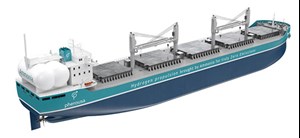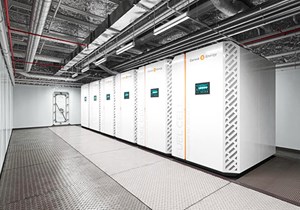Articles
H2Tech: Tech Spotlight
H2 STORAGE AND TRANSPORTATION APPLICATIONS
Pherousa Green Technologies launches zero-emission deep-sea shipping technology
Hydrogen (H2) is the only zero-carbon emissions fuel, but H2 storage is the biggest challenge for deep-sea shipping. Pherousa Green Technologies AS (PGT) has developed and proved the technical feasibility of an ammonia cracker, enabling the use of ammonia as a H2 carrier onboard vessels in deep-sea shipping.
The company is in the design stage of ordering up to six modern green-profiled Ultramax dry bulk carriers designed by Deltamarin in Finland. The initial ship design is based on an existing Deltamarin Ultramax model, adapted for Pherousa Green Technology using ammonia, enabling true zero-emissions propulsion.
PGT’s ammonia cracking technology will allow ship engines to operate with minimal pilot fuel. The system also enables the use of pure H2 in proton exchange membrane (PEM) fuel cells instead of direct ammonia fuel cells for electric power production.
H2FLY integrates and commissions a liquid H2 storage system for H2-electric aircrafts
H2FLY has completed liquid H2 on-ground coupling tests with its HY4 aircraft for the first time. This achievement is part of the European project HEAVEN, a consortium of six companies to demonstrate the feasibility of using liquid, cryogenic H2 in aircraft, led by H2FLY. The new liquid H2 storage system, which is designed and supplied by Air Liquide based on H2FLY’s requirements, has been successfully coupled with the fuel cell system on the ground.
This coupling represents the final technological building block in the development of a complete H2-electric powertrain using liquid H2 to power the HY4—H2FLY’s four-seater demonstrator aircraft, which runs on H2 and fuel cells producing zero-emissions and demonstrating the feasibility of H2-electric propulsion systems for aircraft. The company led the test campaign on Air Liquide’s Campus Technologies Grenoble in Sassenage, France.
Provaris showcases compressed H2 floating storage concept
Australia’s Provaris Energy has revealed a gaseous H2 floating storage concept that has been granted approval in principle by the American Bureau of Shipping (ABS).
The solution, dubbed H2Leo, has a design capacity range of 300 t−600 t of H2, expandable to up to 2,000 t. The company said the unit is suitable for various H2 supply chains and applications, including bunkering for the maritime sector, intermittent/buffer storage for green H2 production and long-duration storage for excess renewable energy.
The H2Leo will have two cargo tanks with independent isolation, safety valves and manifolds for compressed H2 transfer. ABS has conducted risk and safety workshops to assess and mitigate H2 handling risks. Provaris said it will work with ABS for design approval, cargo tank testing and construction. The H2Leo class will have a fixed beam and depth of 31 m and 17 m, respectively, with length and draft varying according to the specified cargo capacity.
The cost of large-scale static storage is estimated by external studies to be in the range of $1 MM/t−$2 MM/t of storage installed, while Provaris claims that the cost of its floating storage solution will target a capital cost of $200,000/t−$300,000/t.
H2 PRODUCTION
New catalyst lowers cost for producing H2 from water
A multi-institutional team led by the U.S. Department of Energy’s (DOE) Argonne National Laboratory has developed a low-cost catalyst for a process that yields clean H2 from water. Other contributors include the DOE’s Sandia National Laboratories, Lawrence Berkeley National Laboratory and Giner Inc.
A PEM electrolyzer runs with separate catalysts for each of its electrodes (cathode and anode). The cathode catalyst yields H2, while the anode catalyst forms oxygen. Unfortunately, the anode catalyst uses iridium, which has a current market price of around $5,000 per ounce. The lack of supply and high cost of iridium pose a major barrier to the widespread adoption of PEM electrolyzers.
The main ingredient in the new catalyst is cobalt, which is substantially cheaper than iridium. Giner Inc. evaluated the new catalyst using its PEM electrolyzer test stations under industrial operating conditions. The performance and durability far exceeded that of competing catalysts.
Understanding the reaction mechanism at the atomic scale under electrolyzer operating conditions is important to advance the catalyst performance further. The team deciphered critical structural changes that occur in the catalyst under operating conditions by using X-ray analyses at the Advanced Photon Source at Argonne. They also identified key catalyst features using electron microscopy at Sandia Labs and Argonne’s Center for Nanoscale Materials.
8 Rivers announces technology breakthrough to develop ultra-low carbon H2 and ammonia
8 Rivers has announced a groundbreaking advancement in H2 technology that could revolutionize the production of ultra-low carbon H2 and ammonia. 8 River’s 8RH2 technology, invented by Rodney Allam, MBE, harnesses advanced CO2 processes in a CO2 convective reformer (CCR). 8RH2 can capture more than 99% of carbon emissions at a cost and scale and can redefine what is possible for global decarbonization.
While many carbon capture technologies target a 90%−96% capture rate, the 8RH2 oxy-combustion process will eliminate nearly all direct CO2 emissions. Unlike standard H2 production, 8RH2 uses natural gas and pure oxygen, utilizing the CO2 produced in the combustion process as a heat transfer medium in a proprietary reformer before sequestering the CO2. 8RH2’s advanced process eliminates the need for costly amine or cryogenic-based CO2 separation processes that are normally required to capture CO2, as carbon separation is inherent to the process itself.
The ultra-low carbon H2 then can be turned into ultra-low carbon ammonia, which in turn can be used for decarbonized fertilizer, zero-carbon maritime fuels and as a zero-carbon feedstock fuel to replace coal in existing power infrastructure. Ammonia is easily stored in bulk at modest pressures, has an existing global distribution network and is easier to transport than H2. Ammonia can be easily cracked back into H2 after reaching its end user. 8RH2-produced ammonia will provide a transportable low-carbon source of H2, a low-cost and scalable solution to accelerate the global transition to net zero.
Cactus plant inspires cost-effective H2 production
Engineers at The University of Texas at El Paso have proposed a low-cost, nickel-based material to help split water more cheaply and efficiently. Their inspiration? A desert succulent known as the prickly pear cactus. The material is described in a new paper in the journal ACS Applied Materials & Interfaces.
Electrolysis is the process of splitting water with electricity and an electrocatalyst—a material that speeds up any chemical reaction. Current techniques to split water rely heavily on platinum as a catalyst, which has its drawbacks. The team had been exploring nickel as a catalytic replacement for platinum, a metal that is abundant on Earth and 1,000 times cheaper than platinum; however, nickel is not as quick and effective at breaking down water into H2.
To combat this limitation, engineers designed a 3D nickel-based catalyst in the shape of a prickly pear cactus. The larger surface area could accommodate more electrochemical reactions—creating more H2 than nickel typically can. The team quickly designed the nano-scale structure—invisible to the human eye—and put it to the test. When tested, the catalyst displayed the ability to split water repeatedly with good results. The process needs further refinement but is a step in the right direction.
Bloom Energy demonstrates H2 production with solid oxide electrolyzer
Bloom Energy has begun generating H2 from its solid oxide electrolyzer installation at NASA’s Ames Research Center, the historic Moffett Field research facility in Mountain View, California. This high-temperature, high-efficiency unit produces 20%−25% more H2 per megawatt (MW) than commercially demonstrated lower temperature electrolylzers, such as proton electrolyte membrane (PEM) or alkaline.
This electrolyzer demonstration showcases the maturity, efficiency and commercial readiness of Bloom’s solid oxide technology for large-scale, clean H2 production. The current demonstration expands on Bloom’s recent project on a 100-kilowatt (kW) system located at the Department of Energy’s Idaho National Laboratory (INL) that achieved record-breaking electrolyzer efficiency. In the ongoing project, 4,500 hr of full load operations have been completed with the electrolyzer, producing H2 25% more efficiently than low-temperature electrolysis.
The INL steam and load simulations replicated nuclear power conditions to validate full capability of technology application at nuclear facilities, and the pilot results revealed the electrolyzer producing H2 at 37.7 kWh/kg of H2. Dynamic testing conducted at INL included ramping down the system from 100% of rated power to 5% in less than 10 min without adverse system impacts. At 5% of rated load, the energy efficiency (kWh/kg) was as good or better than other electrolyzer technologies at their 100% rated capacity.
H2 EQUIPMENT
Flowserve introduces Worcester® 51/52 Series reduced port flanged ball valves
Flowserve Corporation has released its Worcester® 51/52 Series reduced port flanged ball valves. These quarter-turn, floating ball valves have been reengineered for global availability by standardizing design, materials, construction and product certifications. Target applications for the valves include controlling the flow of liquids or gases in the H2, chemical processing, petrochemicals, energy, industrial gases and water industries.
The bubble-tight shutoff design and robust, live-loading packing in these valves minimize fugitive emissions, enhance safety and maximize regulatory and standards compliance. The valves ensure positive retention and greatly reduce blowout risk by featuring a redesigned end plug.
In addition to improving safety for workers, process fluids and equipment, customers will benefit from lower total cost of ownership thanks to the interchangeability of widely available parts. Flowserve’s technical services are also available through the company’s global network of quick response centers.
ION Science releases highly sensitive gas leak detector
ION Science has launched its new Panther gas leak detector, featuring a host of new features and twice the sensitivity of its predecessor, the GasCheck G. The first GasCheck was launched in 1990, offering industrial users the ability to detect leaks of gases, such as H2 and helium. Later, more advanced versions were developed with new features, such as over-range protection and audible alarms.
The new Panther PRO represents a quantum leap in technology: a highly sensitive thermal conductivity sensor that can rapidly detect a variety of gases—the most popular applications are helium, H2, ammonia and refrigerants.
The Panther PRO allows users to zero the instrument in ambient air, providing visual, audible and vibration alarms when leaks are detected. A color LCD and built-in gas table enable concentration measurements and leak rates in various user-selectable units. All measurements can be logged internally and downloaded via Bluetooth or USB. The Panther also features an integrated torch and a flexible probe, which help in low light and restricted areas.
Corvus Energy launches maritime H2 fuel cell systems
Corvus Energy has launched a gas-safe marine fuel cell product, the Corvus Pelican Fuel Cell System (FCS). The new product represents a significant leap forward in safe, clean and efficient power generation for marine vessels.
The Pelican FCS is the result of the H2NOR, a research project initiated in 2021 by Corvus Energy, Toyota and other partners to fast-track the development and production of sustainable and scalable maritime H2 fuel cell systems.
Utilizing the well-proven fuel cell technology from Toyota, used in more than 20,000 cars, and adding the safety level needed for marine, enables the Pelican FCS to be installed anywhere onboard a vessel. The modular and flexible system is designed to be inherently gas safe, meaning that the surrounding machinery space is considered gas safe under all conditions. This significantly reduces the requirements of safety support systems and ventilation, thereby enabling more efficient integration of the FCS inside the ship’s hull.
SwRI designs safer, more effective H2 injector for gas turbines
Southwest Research Institute is designing innovative H2 combustion systems for gas turbines used in power generation. The designs prevent flashback, a common concern in H2-fueled combustion systems, wherein the flame from the combustor travels into the nozzle, which can result in damaged equipment.
H2 fuel has numerous benefits, including the fact that it produces no carbon emissions during the combustion process; however, it is highly reactive, which makes it more difficult to work with than natural gas or the liquid fuels that gas turbines typically run on.
To remedy this, SwRI is exploring novel ways to mix air and H2 within the nozzle while avoiding flashback. The designs, which also target very-low nitrogen oxide (NOx) emissions, were generated as part of a project supporting the development of a 100% H2-fueled combustion system for an industrial gas turbine.
The nozzles work by mixing air with H2 fuel through small, perpendicular pathways. This design allows the air and H2 to mix rapidly before being forced out of the nozzle and into the combustor at flowrates that prevent flashback.






